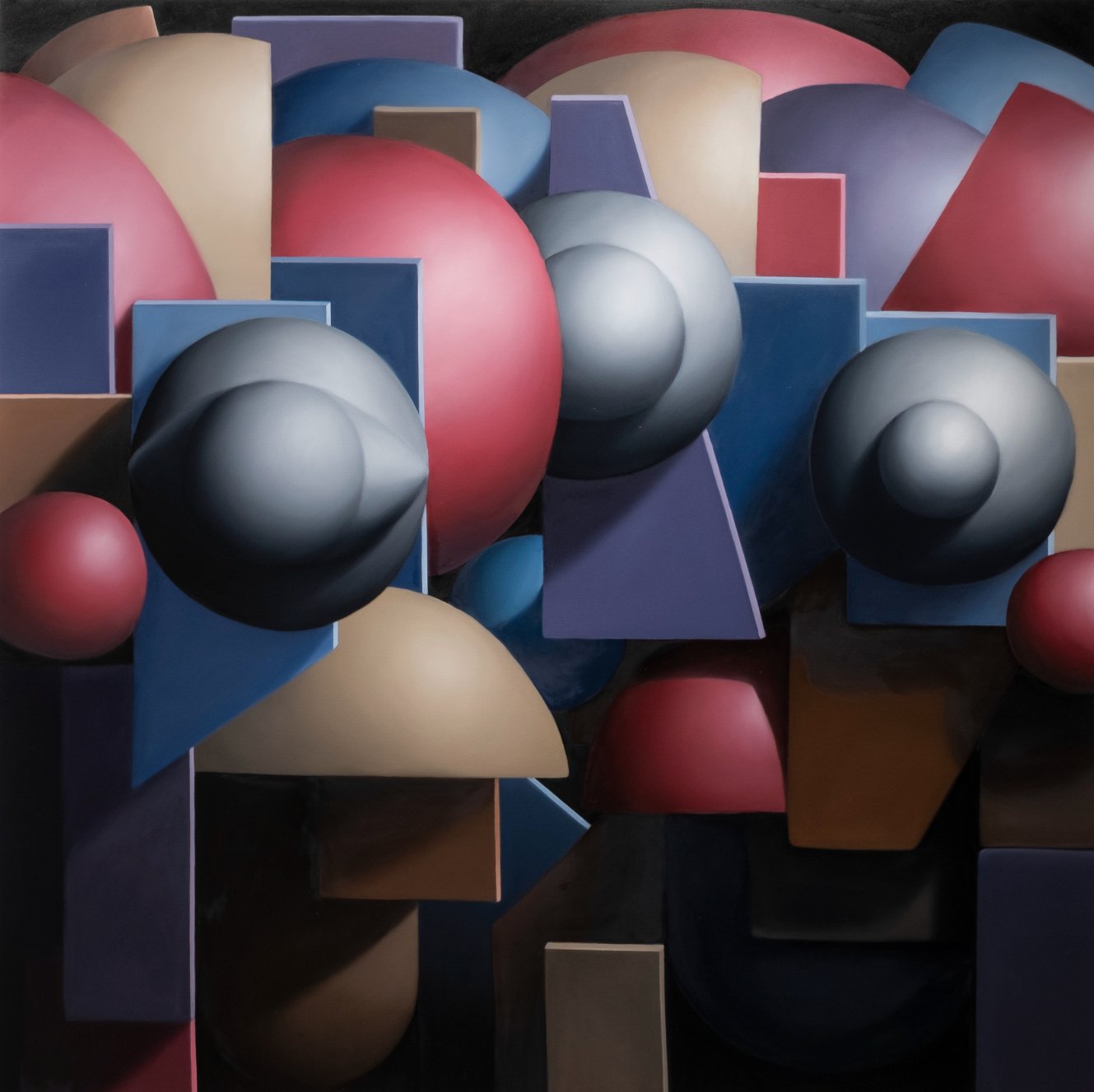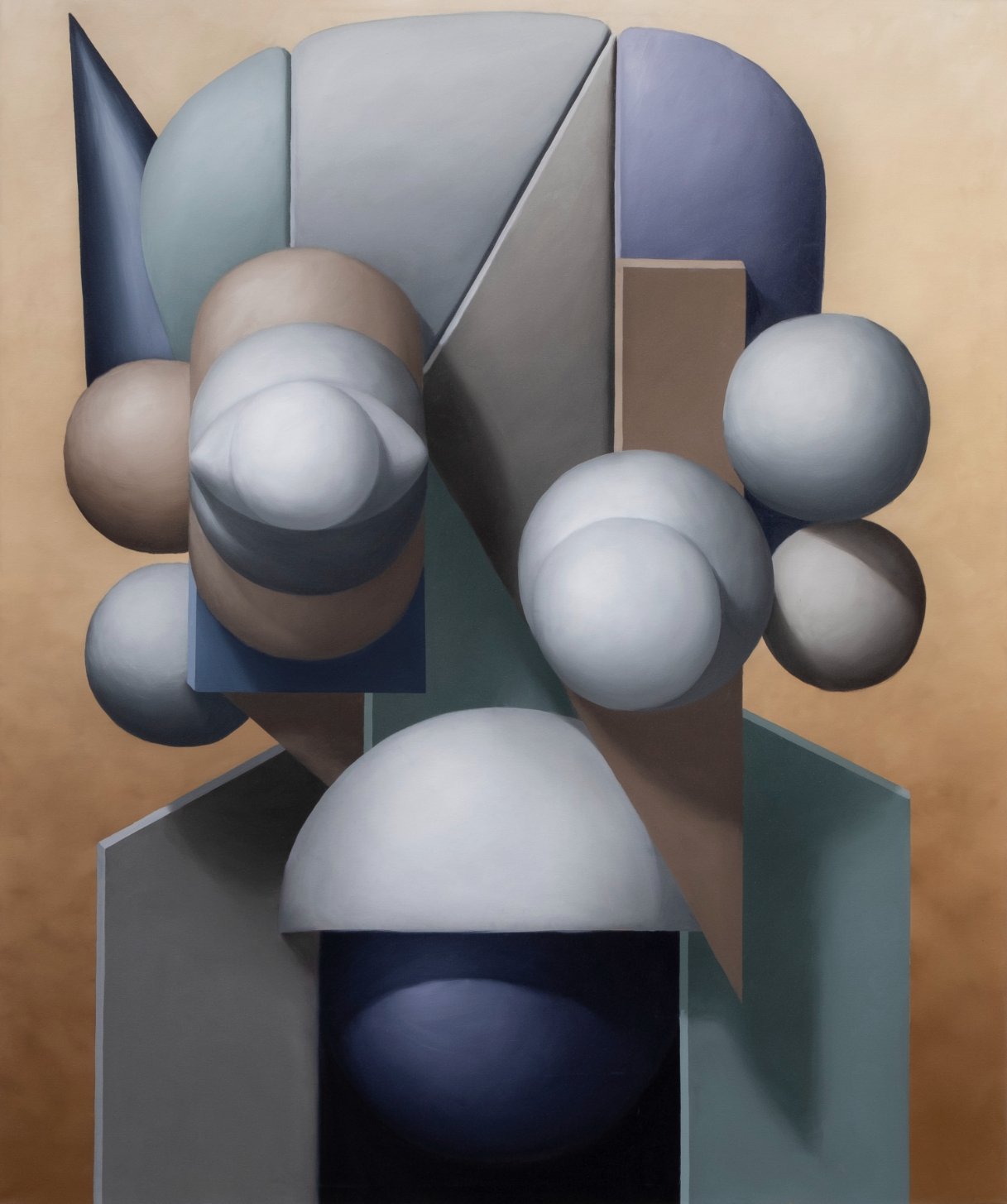text by Stella Peacock-Berardini
Devon Dejardin’s exploration of art may have started from the humble encouragement of a sugar daddy psychic, but it has grown into a journey of healing and reflection that continues to drive his success in the art world. Within his cubist-influenced style of work, Devon Dejardin, an LA-based painter, processes through the elements of life demanding answers to all of its most urgent lingering questions. Dejardin employs his work as a way to unpack and understand the entropic nature of the universe through his lens of belonging, going deeper into the storms he's faced that brought him to the clear sky of his creation. This 29-year-old, self-taught artist originating from Portland juggles depression and anxiety within the creative realm and expresses his gratitude for the therapeutic release his art supplies to himself and its viewers. His newest project, Giants dives into this preconceived idea of spirituality and shifts its narrative to his ideas surrounding the guardians of the world, those that protect, aid, and grow in strength and vulnerability within the boundaries of our world. His art, huge in size, mimics the ideas of giants and how they are commonly perceived, yet it develops further than that. These feelings, or challenges in life, such as sadness or grief materialize as giants, but represent the deception life can have on us all. We sat down with this artist to explore his influences, conceptions around his work as a whole, and his first New York solo exhibition at Albertz Benda.
AUTRE: We live in an age of anxiety and uncertainty—you are an artist who found refuge in painting, how has your adolescent experience with anxiety and now as a painter prepared you for our current zeitgeist?
DEVON DEJARDIN: It taught me that sometimes we need to go to dark places in our life to gain a better understanding of ourselves and our place in this world. Anxiety and painting both can create times of uncertainty. However, if you continue to push and wrestle with what is in front of you, oftentimes beauty is birthed. I almost feel times of anxiety have become a guardian for me. It slows me down, humbles me and redirects me … very similar to the process of creating a painting.
AUTRE: Are you hopeful about the future or is there a sense of pessimism?
DEJARDIN: Always hopeful. Pessimists are depressing to be around. Even in the worst of things there is so much good. So much of life has to do with perspective and looking at situations from all different angles.
AUTRE: Your work utilizes a lot of abstract forms, it’s almost cubist, but also extremely reflective of our 21st-century digital age, how would you describe these forms?
DEJARDIN: So much of our current physical reality is constructed by a few simple shapes that are altered and manipulated to form structures. We see these shapes in architecture, art, design, nature etc. When approaching this series of work I wanted to use these simple shapes to create something powerful. To show how the manipulation of simple constructs can form something that speaks and carries weight. The idea that simplistic forms can carry a complex identity.
AUTRE: Do you feel like the forms in your paintings are ominous or do you see them more as benevolent entities?
DEJARDIN: I think that if you look at history much of the benevolent entities we have learned about are described to be quite ominous. To answer the question, I see both. Many religious texts speak on the idea of an entity saying “fear not” before they reveal themselves. Why? I think encountering any sort of spiritual being … light or dark … would be pretty intimidating.
AUTRE: Do you dream about unrealized paintings or imagine them before the paintbrush hits the canvas, or is it an intuitive experience?
DEJARDIN: Yes and no. There are many times where it is a free flow battle aimlessly moving paint until a picture appears. However, I tend to lean more towards a controlled intuitive process. A process where sketching, creating studies, and spending time thinking give way to a much more intimate painting. I find myself lately really enjoying the process of drawing before painting. Reimaging the same painting multiple ways.
AUTRE: Your new work that will be on view at Albertz Benda is inspired by spiritual allegory, when and why did you become interested in this subject matter?
DEJARDIN: From a young age I was always interested in the concepts of “where did we come from?” and “what is next?” Spirituality or religion are primary disciplines for investigating the boundary questions of life and death, of love and hate, that characterize the human condition. All persons crave for self-transcendence in one mode or another. Religious Studies provides the opportunity to understand, with depth and nuance, the many beliefs and rituals that move persons to appreciate the alternative world of reality. I think it is important to have a strong understanding of the major concepts humans use as a framework to exist…
AUTRE: Can you talk a little bit about the parable of David and Goliath and how that fits into your new work?
DEJARDIN: Much of this exhibition stems from Malcolm Gladwell’s 2013 book, David and Goliath: Underdogs, Misfits, and the Art of Battling Giants. This book was an investigation into the relationship between underdogs and giants.
In the book, Gladwell discusses a story from the Bible about David and Goliath. The Israelites were in war with the Philistines, but they were at a disadvantage to win because of the champion, Goliath. Goliath suffered from acromegaly which made him a physical giant and no one wanted to fight him. However, David stepped up to fight him even though he didn’t think he could defeat Goliath. We learn that due to Goliath's growth disorder he suffered from many physical ailments such as vision impairment, lack of coordination etc. making David, a slinger, a much more evenly matched opponent. David was easily able to defeat Golith even though the odds seemed to be against him. The simple lesson is that often these “Giants” in our lives often are not as “big” as they seem. The work in this exhibition tells the story of pushing through and ultimately moving past “Giants” in our lives.
AUTRE: You are displaying some large sculptures at the new show—can you talk a little more about these sculptures and the materiality, and what has the experience been going from two dimensions to three?
DEJARDIN: I've always wanted my work to be able to be seen in all different kinds of settings and landscapes. Painting is limited to primarily being able to be indoors but I think there's so much power in allowing work to be placed in all different types of environments. These sculptures created for the show are made of bronze and will be able to live in earth's elements for hundreds of years.
The experience going from 2D to 3D is something that I'm still learning. I'm being mentored and taught. I'm working alongside people that are far more experienced than I am at sculpting and it is a process that takes many hands. The process goes from taking an original sketch, making it into a painting, and then I bring it into a 3D format on the computer to envision what these paintings would look like from all angles. For me, that's the tricky part because all of my paintings and portraits are forward-facing. Taking on a side angle or the back angle and creating balance within that has been the most time-consuming part of it.
AUTRE: When you are working in the studio, do you have something that jump-starts the creative process—do you listen to music, is it a solitary experience or do you like to have a lot of activity?
DEJARDIN: For four years I painted alone and most of the time without music. I found solitude to be a form of therapy and the time alone helped me start to better understand my place in this world. It allowed me to gain a better sense of my voice. Now, I enjoy the communal aspect of having people in and out of the studio. I like to bounce ideas and break up my thought patterns in hope that more ideas will come forth. I think we as humans are designed to be in community with one another and I'm starting to see a much more healthy balance with how I approach my work.
AUTRE: A lot of your new show explores misrepresentations, but what about you as an artist—are there things that people get wrong about your work or you as an artist?
DEJARDIN: I am sure there are many misrepresentations about me and my work floating out there. It is not something that I need to focus on. My work is a reflection of my truth and my identity. I am responding to an innate pull to create and to share ideas with the world. If people want to twist, pick, and misinterpret … all are welcome.
Devon DeJardin: Giants is on view June 30 - August 5 @ Albertz Benda 515 W 26th Street New York





